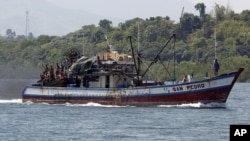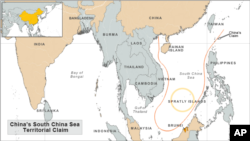On Thursday, China’s state media said most Chinese travel agencies suspended trips to the Philippines in an escalating and nationalistic war of words over a disputed island chain. China also issued a safety warning to its citizens in the Philippines because of anti-China protests expected this weekend.
Foreign affairs spokesman Hong Lei on Thursday demanded the Philippines ensure that Chinese citizens are safe. The Philippines side encouraged people both at home and abroad to launch demonstrations against China, he said, warning authorities to take measures to protect the safety of Chinese nationals and institutions in the Philippines.
The rising tension came from a face-off last month after a Philippine warship tried to stop Chinese fishing boats in the Scarborough Shoal, but were stopped by surveillance ships from China.
The rocky islands, known as Huangyan in China, are in the South China Sea, about 230 kilometers northwest of the Philippines.
Manila says the shoal is within its exclusive economic zone while Beijing claims not only those islands but almost all the territory in the South China Sea.
That puts China in conflict with other claims in mineral and fishing-rich areas by Brunei, the Philippines, Malaysia, Taiwan, and Vietnam.
Political analysts say Beijing’s argued sovereignty of the region is weak because it is based on historic claims rather than international law.
Carl Thayer, a professor at the Australian Defense Academy, points out that a map China gave the United Nations in 2009 that justified its territorial claims had nine unconnected lines drawn in the sea.
“[Un]til China comes clear about what the nine dash lines mean and how they would be connected, and how the claims [are] under international law -- but they claim historic rights. Well, the United Nations Convention on the Law of the Sea came recently. So, you can’t go back and say back when we had historic rights, we also claimed international law because it didn’t exist. So, we’re still stuck on the Chinese ambiguity. Some argue that it’s calculated. It suits China to keep everybody guessing," Thayer said.
Conflicts among claimants in the sea are not new and have, in the past, involved arrests of Chinese and Vietnamese fishermen and even brief naval battles in the 1970s between China and Vietnam.
But worries are growing about the possibility of greater conflict as China asserts its power and influence to claim resources and the United Sates backs up its ally, the Philippines, with increased arms sales.
To ease tensions, the Association of Southeast Asian Nations has for more than a decade been negotiating details on a code of conduct in the South China Sea.
The regional grouping has set a deadline for reaching an agreement in July, when Thailand will become the ASEAN-China coordinator.
Thitinan Pongsudhirak, director of the Institute of Security and International Studies at Bangkok’s Chulalongkorn University, said Thailand, as a non-claimant, is in a good position to act as an arbiter, but is coming under pressure from both Beijing and ASEAN.
“China prefers to deal with ASEAN on a bilateral basis," said Thitinan. "And, ASEAN itself does not have a single, common position on the South China Sea. So, we will see from Beijing, most likely, a kind of divide and deal posture. At the same time the ASEAN countries, especially the claimant countries - particularly The Philippines, Vietnam, Malaysia - they will want ASEAN to come up with a common position. And, this will put some
pressure on Thailand.”
Political analysts say the Philippines and Vietnam are pushing for a binding code of conduct that also clarifies geographic claims in the sea while China wants a weaker and ambiguous declaration.
ASEAN’s ten member nations make decisions based only on consensus and China must also accept the agreement. That makes a clear and enforceable code less likely and a watered down list of principles like the 2002 Declaration of Conduct, or DOC, said Thayer.
“If it’s not going to have what the Philippines wants as an enforcement mechanism, it doesn’t have a status as a treaty, it’s not going to be any more binding than the DOC, which, when you get down to the bottom, makes a net assessment, is nothing more than a political declaration of voluntary activities.”
ASEAN’s other members include Burma, Indonesia, Laos and Singapore.






